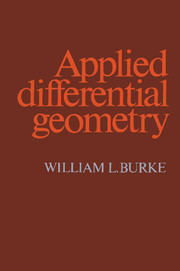Book contents
- Frontmatter
- Contents
- Preface
- Glossary of notation
- Introduction
- I Tensors in linear spaces
- II Manifolds
- III Transformations
- IV The calculus of differential forms
- V Applications of the exterior calculus
- VI Classical electrodynamics
- VII Dynamics of particles and fields
- VIII Calculus on fiber bundles
- IX Gravitation
- Bibliography
- Index
VIII - Calculus on fiber bundles
Published online by Cambridge University Press: 05 June 2012
- Frontmatter
- Contents
- Preface
- Glossary of notation
- Introduction
- I Tensors in linear spaces
- II Manifolds
- III Transformations
- IV The calculus of differential forms
- V Applications of the exterior calculus
- VI Classical electrodynamics
- VII Dynamics of particles and fields
- VIII Calculus on fiber bundles
- IX Gravitation
- Bibliography
- Index
Summary
Physical theories today are predominantly field theories. The geometric view of fields is that they are sections of fiber bundles. Handling the local relations (partial differential equations) between fields requires some care when we are working on manifolds, and the difficulty comes from an unexpected direction. We can do ordinary calculus with no trouble. The local affine approximations to these sections will be contact elements. This calculus is done in the jet bundle. The difficulty lies in deciding which contact element represents a constant field. A similar problem exists, say, for angles. Until we are given the geometric structure of a metric, the idea of an angle on a manifold does not exist.
Example: There is no problem in deciding what a constant realvalued function is. Thus it is easy to physically measure the temperature everywhere in a building, and mathematically easy to recognize when it is constant.
Not so for a field variable that is a vector. Because of this we are unable to define globally the state of rest on spacetime, and thus are not able to define, for example, the total energy of an expanding universe. Does the kinetic energy of the expansion count or not? This is not a problem of inadequate mechanics. There is no physical meaning to the question.
If there is to be physical meaning to the idea of a constant field, then it must be added to the bundle, and we need some mathematical structure to represent it.
- Type
- Chapter
- Information
- Applied Differential Geometry , pp. 347 - 370Publisher: Cambridge University PressPrint publication year: 1985

